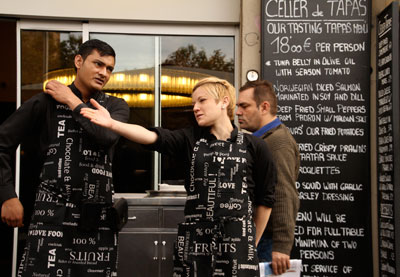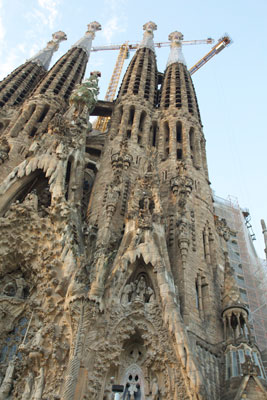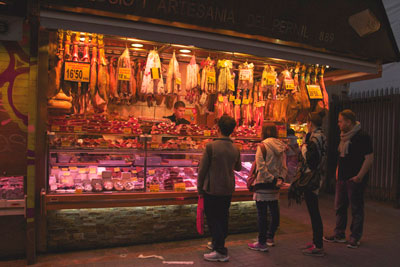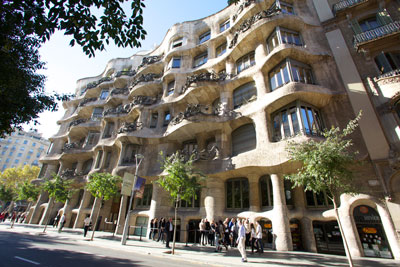Avoiding the crowds on an off-season visit to Barcelona
This article appears on page 6 of the May 2014 issue.
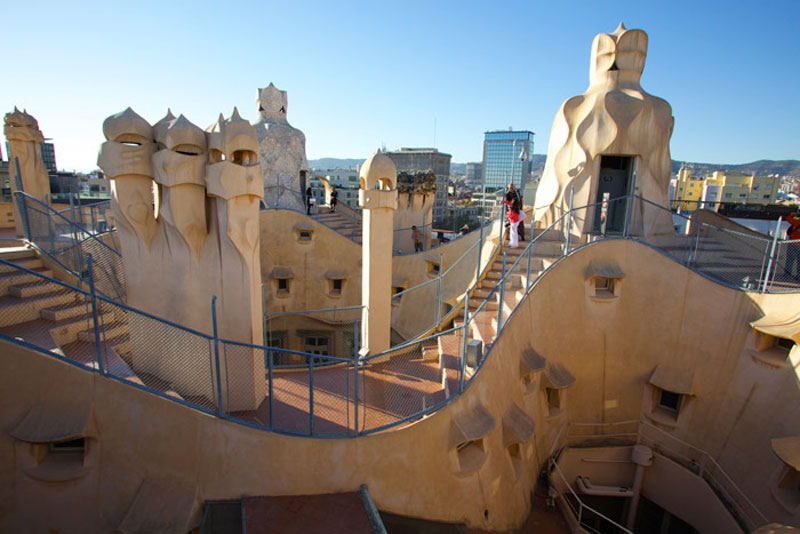
by Ken Mallory — Newton Heights, MA
Lured by an invitation from my wife’s cousin and her daughter to visit them in Mallorca, Spain, in November 2013, my wife, Margaret, and I discovered the many benefits of off-season travel to a country that overflows with visitors during the high season in spring and summer.
While our week-long stay in the town of Pollença offered a chance to renew friendships and stories of family (and enjoy a day of olive picking at a local finca), it was our 2-day stopover in Barcelona that revealed the pleasures of off-season travel in a city that, in the summer, can attract as many as four million visitors per month.
Las Ramblas
Barcelona’s airport is a 30-minute taxi ride from Nouvel Hotel, the hotel we chose for our visit. It was located just off the bustling city street called Las Ramblas, or “Les Rembles” in Catalan. Catalan is the main language spoken in Barcelona, but almost everyone also speaks Castilian Spanish, and English is used in most tourist-related venues.
There are plenty of 4- and 5-star hotels that border Las Ramblas, but we preferred a less-expensive place situated a little distance away from the noise of the main street. The cost of a night’s stay, with a 20% off-season discount, was slightly over $100, including breakfast. Although there was still some street noise and our room was simple and unluxurious, the central location made it a good choice for us for walking around the city.
As we took our first walk down Las Ramblas, street performers painted from head to toe reminded us of our visit to the Las Vegas strip a few years before. They posed, motionless like statuary, to attract curious onlookers, then suddenly began to move. Compared to Las Vegas, however, the tree-lined setting with buildings, some of which dated back to Roman times, imbued the boulevard with a distinctly Old World flavor.
Artist Joan Miró’s pavement mosaic of abstract shapes in colors of yellow, blue and red lay underfoot at the Pla de l’Os; tapas restaurants offering snacks and appetizers poked tables and chairs invitingly out into the Ramblas corridor; street artists drew pictures of any passersby who wanted mementos; street vendors roasted sweet potatoes, and the local food market, La Boqueria, was stocked with persimmons, oranges, clementines, olives, Serrano hams, sardines, anchovies and kale all day, every day — a foodie’s delight.
Exploring on foot
Barcelona is a mecca for students of art and architecture, and this fact is what motivated many of our walks. Buildings by celebrated architect Antoni Gaudí, who died in 1926, appear like jewels throughout the city, with seven of his buildings granted World Heritage status by UNESCO.
What makes an off-season tour of the city — in particular, the Gaudí buildings — so special is the comparatively easy access to these popular sites, which otherwise would require reservations. For us, there was no waiting in line.
Barcelona is divided into 10 districts, including the Old City, where our hotel was located, Eixample, the renovated part of Barcelona, now containing La Sagrada Família and Casa Milà, and the hilly promontory called Montjuïc, which contains the Joan Miró Foundation & Study Center and the National Museum of Catalan Art, among other attractions.
During the early evening of our arrival, we wandered the length of Las Ramblas, from the city-center plaza, Plaça de Catalunya, to the waterfront, with its 200-foot-tall statue of Columbus, its flotilla of yachts and powerboats, its large public aquarium, and the beaches that were renovated for the 1992 Summer Olympics.
La Sagrada Família
Following our evening meal at a nearby restaurant, Margaret and I went to bed early so we could be prepared for our morning visit to La Sagrada Família, Gaudí’s most celebrated architectural masterpiece, though it’s still a work in progress. We secured tickets for 9 a.m. online before we left Boston, but, judging by the crowds, we probably could have gained entrance even without a reservation.
Although convenient Metro and bus transport is available, we took a taxi to make sure we arrived on time. The first things we noticed were the basilica’s gigantic towers, flanked by construction cranes hundreds of feet tall. Publicity says the architectural team that took over after Gaudí’s death hopes to finish the building by 2026, the 100th anniversary of his death.
Not everyone is so optimistic. Gaudí was hired to finish what began as a neo-Gothic cathedral in 1883; it turned into a lifelong commitment, a quarter of which was completed before his death. In its quest to create a church that is a celebration of the Bible, the team that inherited Gaudí’s dream has faced many obstacles, including a 1936 firebombing during the Franco civil war that destroyed most of Gaudí’s architectural plans and models.
As documented in the many multilingual interpretive stations around the inside of the church, the basilica will eventually include 18 towers, 12 representing the Apostles, four for the Evangelists, one for the Virgin Mary and a final tower stretching above all the rest to represent Jesus Christ. The full history of La Sagrada Família is beyond the scope of this brief recounting of what we saw.
A look inside
At the 9 a.m. entry time, we walked through the entrance of the western façade, called “The Passion,” where sculptures depict stark images of the story of the Calvary cross and the events that led up to the crucifixion of Christ.
In contrast to this scene of suffering on the outside, the church’s interior was awash in shimmering color. Shafts of light flooded through the stained-glass windows, many of which were created to commemorate shrines and saints linked to the local church.
In any exploration of the interior of the church, time and close observation are required to fully appreciate the biblical stories and symbolism represented. We used the audiotape tour to help acquaint us with the many Christian themes.
We joined groups of locals, including grade school and college students, in appreciating the “organic” architecture so characteristic of Gaudí’s style. A forest of interior columns of various kinds of stone rose like tree trunks to support the roof.
As a leader in the architectural style known in Spain as Modernisme, Gaudí employed decorative forms inspired not by the impersonal industrial aesthetic that preceded this style but by rounded, curved organic forms and shapes found in nature. Besides the forest of tree-like columns, there were many sculptures on the basilica’s façade depicting birds, turtles, flowers, fruits and other natural forms.
Casa Milà
A 10-minute walk from La Sagrada Família toward one of Barcelona’s other main thoroughfares, Passeig de Gràcia, led us to Casa Milà, also known as La Pedrera.
Following a cholera epidemic in 1854, the ancient wall that surrounded Barcelona was torn down to create an urban network of streets called Eixample. La Pedrera is one of the remarkable examples of Modernisme architecture constructed during the renovation.
La Pedrera was the last of Gaudí’s commissions before he devoted himself to La Sagrada Família, and, like many other Gaudí projects, its sponsorship came from a rich industrialist, this time one from the textile industry, Pere Milà. The building was completed in 1912 and was intended as a home for Milà and his family. This multistory building was designed to provide living space for up to 20 additional families.
Entry to what has become a showcase museum came without any waiting in line but, instead, with a reminder of the political times: any bags or backpacks had to be passed through an x-ray machine.
Pastel-colored murals decorated the ground floor, where a sweeping staircase led to the mezzanine level, reserved for the Milà family; elevators and stairwells led to the other apartments.
Wrought-iron gates and patio railings displayed the artistic flourishes that remind the visitor that Gaudí came from a family of metalworkers. The whimsical ceiling and wall art of the entry level represent mythological themes from the 16th century, but the most dramatic architectural features appeared on the rooftop, where a garden of chimneys and air vents displayed signature Gaudí style.
Although Asian, American and German travelers were among those exploring the roof, their numbers were relatively small, allowing us to admire the 30 chimneys, two ventilation towers and six stairwells as well as the view of the city streets below.
The chimneys and ventilation towers, which allow heat from the basement and apartments below a chance to escape, brought to mind Darth Vader’s helmet.
The stairwells featured a favorite Gaudí design technique called trencadís, in which broken pieces of ceramic tile are fitted as a skin coat over the looming structures. We followed one of these stairwells to a showcase apartment with furnishings typical of the Catalan bourgeoisie of the early 1900s.
Tasty tapas
No diary of a trip to Barcelona would be complete without mentioning the tapas restaurants that can be found on any walking tour along Las Ramblas and its tributary streets.
Tapas are a variety of small, tasty Spanish dishes, often served as snacks with drinks or combined with other tapas for a meal. Based on convenience and recommendations from our hotel, we traveled each evening to one of the several Taller de Tapas restaurants, where we tried grilled tuna with roasted peppers (€10, or $14); skewered chicken marinated in herbs and spices (€7); seafood paella (€13.50); pan-steamed mussels with Mediterranean herbs (€5.50), and the classic Spanish dish called pa amb oli, toasted bread rubbed with tomato and seasoned with salt and olive oil.
Although the city’s architectural works of art are reason enough to tour Barcelona, a longer stay in the city offers a wealth of other experiences. The Picasso Museum, the Liceu Theater, the Roman ruins (such as the Temple of Augustus), The Aquarium and the waterfront are just some of the many delights you can discover during an extended stay.
Barcelona has mild temperatures for most of the year, and, while winter can dip into the 50s, we enjoyed temperatures in the 60s during our November tour of the city.
Off-season travel to Barcelona has much to offer the international traveler.

